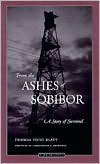From the Ashes of Sobibor: A Story of Survival
When the Germans invaded Poland on September 1, 1939, Thomas Toivi Blatt was twelve years old. He and his family lived in the largely Jewish town of Izbica in the Lublin district of Poland - a district that was to become the site of three of the six major Nazi extermination camps: Belzec, Sobibor, and Majdanek. Blatt's account of his childhood in Izbica provides a fascinating glimpse of Jewish life in Poland after the German invasion and during the periods of mass deportations of Jews to the...
Search in google:
Thomas Blatt was a 14 year old youth, after being caught escaping from the ghetto in Izbica, his Polish home town then under the Nazi rule, escaped again and without hope returned to the ghetto. Two weeks later he and his family were send by the Nazis with the last Jews of Izbica to a death camp Sobibor. There he was selected for work. While a slave worker he became part of the underground preparing a revolt and escape. The imagination is gripped when you follow Mr. Blatt's compelling description of the development and implementation for the plan that would result in the biggest and most successful revolt in any Nazi camp. This is a powerful story of a tragic part of history and a fitting tribute to the many men and women of Sobibor who lost their lives rising to rebellion on October 14, 1943. It's a story never to be forgotten. Though the author writes economically and has constructed the narrative quite well, it retains an appealingly unstudied quality. Moreover, Blatt treatment of such matters as the shtetl where he lived, Jewish-Polish relations, variations in German behavior, and the Sobibor camp itself, all strike me as sufficiently distinct from earlier printed accounts. Most riveting of all, in my opinion , is Blatt's extraordinary odyssey after the escape from Sobibor until liberation. This book is engrossing and at times riveting. The world that Thomas Blatt exposed for the reader in a very matter-of-fact, painfully honest way, shares time in history that was created by ignorance, hatred and anicent prejudices. Most compelling is a added-on segment that contains Thomas Blatt's face-to-face interview in Germany of Karl Frenzel, the Nazi officer in Sobibor who selected Blatt to be a slave laborer from the line of doomed Jews, including Blatt's parents and little brother. A must read for anyone who is interested in the human nature and the Holocaust. --Mary Song Publishers Weekly In 1958, when Blatt emigrated to Israel, he sent the story of his incarceration and escape from Sobibor to a notable Auschwitz survivor. The names Auschwitz, Treblinka and Dachau had by then become symbols of the horrors of the Holocaust. But the concentration camp at Sobibor was another site where thousands of Jews had been killed, so Blatt must have been horrified when this survivor wrote in response to his manuscript, "`You have a tremendous imagination. I've never heard of Sobibor and especially not of Jews revolting there.'" Forty years later Sobibor's existence is no longer in question. But even today it is a camp shrouded in mystery, in large part, as Blatt points out, because "very little official documentation" survives of Sobibor's existence or operationthis memoir is one of the few eyewitness accounts. Through first-person narrative and reconstructed dialogue, Blatt describes with chilling objectivity the German occupation of his hometown of Izbica, Poland; early Nazi roundups; the transportation of Jews to Sobibor; his own internment there; the inmate revolt that followed on the footsteps of Nazi defeats by the Russians; and finally his flight to and from his hometown. Although parts of this story were printed elsewhere and have been incorporated into Richard Rashke's Escape from Sobibor as well as a 1987 CBS documentary of the same name, this is Blatt's first full-length account and the result of 40 years of work. Blatt's story is a powerfully written memorial to Sobibor's victims. (July)
\ Publishers Weekly - Publisher's Weekly\ In 1958, when Blatt emigrated to Israel, he sent the story of his incarceration and escape from Sobibor to a notable Auschwitz survivor. The names Auschwitz, Treblinka and Dachau had by then become symbols of the horrors of the Holocaust. But the concentration camp at Sobibor was another site where thousands of Jews had been killed, so Blatt must have been horrified when this survivor wrote in response to his manuscript, "`You have a tremendous imagination. I've never heard of Sobibor and especially not of Jews revolting there.'" Forty years later Sobibor's existence is no longer in question. But even today it is a camp shrouded in mystery, in large part, as Blatt points out, because "very little official documentation" survives of Sobibor's existence or operationthis memoir is one of the few eyewitness accounts. Through first-person narrative and reconstructed dialogue, Blatt describes with chilling objectivity the German occupation of his hometown of Izbica, Poland; early Nazi roundups; the transportation of Jews to Sobibor; his own internment there; the inmate revolt that followed on the footsteps of Nazi defeats by the Russians; and finally his flight to and from his hometown. Although parts of this story were printed elsewhere and have been incorporated into Richard Rashke's Escape from Sobibor as well as a 1987 CBS documentary of the same name, this is Blatt's first full-length account and the result of 40 years of work. Blatt's story is a powerfully written memorial to Sobibor's victims. (July)\ \ \ \ \ Library JournalAmong the most common questions asked of Holocaust survivors are why the Jews didn't fight back: Why, it is wondered, did they let their families go to their deaths so easily? The recollections of Blatt, a survivor of the extermination camp Sobibor, in Poland, where Jews staged a successful revolt, addresses these questions in a frank and gripping narrative. Blatt's account demonstrates how the Germans kept Jews in Poland subjugated through random terror combined with promises that the status quo would be maintained if the Jews cooperated. By the time Blatt reached Sobibor with his family, it was too late for resistance. Perhaps the most frightening, and dispiriting, part of Blatt's account is how Christian Poles at times robbed, terrorized, or even murdered Jewish fugitives, such as the Sobibor escapees. A chilling narrative; highly recommended for Judaica collections and Holocaust specialists as well as general readers.Frederic Krome, Northern Kentucky Univ., Highland Heights\ \








